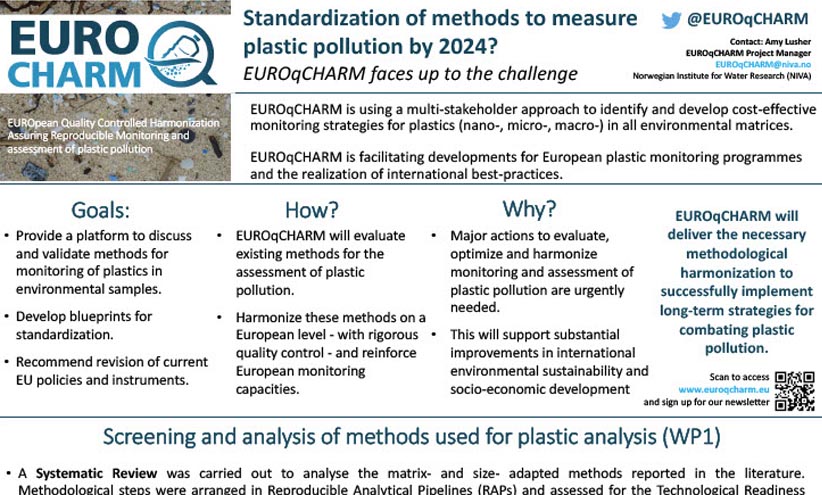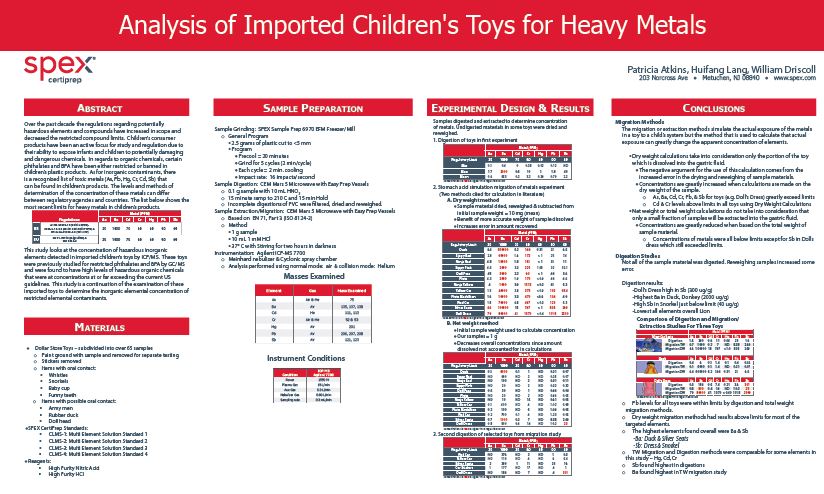Analytical Scientific Posters

High Purity and N-Isomer Specific PFAS Reference Standards
PFAS manufacturing results in products containing both linear and branched isomers, which are therefore found in the environment. Quantitative analysis of PFAS is normally conducted by eluting all isomers together, the mixture of linear and branched isomers presents challenges in providing an accurate quantification of many PFAS in environmental matrices. Isomer-specific analysis of PFAS is difficult due to the lack of analytical instruments and analytical reference materials.

Standardization of Methods to Measure Plastic Pollution by 2024
EUROqCHARM is using a multi-stakeholder approach to identify and develop cost-effective monitoring strategies for plastics (nano-, micro-, macro-) in all environmental matrices. EUROqCHARM is facilitating developments for European plastic monitoring programmes and the realization of international best-practices.
Analysis of Cannabis and Hemp Products for Heavy Metals
The cannabis industry has taken the world by storm and has flooded the market with new products. Recently, concerns have arisen around the safety of this largely unregulated market. Cannabis testing laboratories emerged to fill the need for specialized testing for cannabinoid potency, pesticides, bacteria/mold and other potential contaminants. Sadly, a significant group of contaminants has been largely ignored: toxic metals.
Analysis of Heavy Metal Concentrations and Human Exposure from Hemp Oils and Hemp Products
The cannabis industry has taken the world by storm and has flooded the market with new products. Recently, concerns have arisen around the safety of this largely unregulated market. Cannabis testing laboratories emerged to fill the need for specialized testing for cannabinoid potency, pesticides, bacteria/mold and other potential contaminants. Sadly, a significant group of contaminants has been largely ignored: toxic metals.

Analysis of Imported Children's Toys for Heavy Metals
Over the past decade the regulations regarding potentially hazardous elements and compounds have increased in scope and decreased the restricted compound limits. Children’s consumer products have been an active focus for study and regulation due to their ability to expose infants and children to potentially damaging and dangerous chemicals.
Certifed Reference Materials: Beyond the Basics
What is a Standard?
Chemistry and Cosmetics:Analysis of Lipstick for Toxic Elements Using ICP-MS
Evidence of the use of cosmetics, including lipstick, has been found in civilizations as early as ancient Mesopotamia. Many of the cosmetics used throughout history have contained potentially toxic elements and other contaminations. Ancient Egyptians used cosmetics containing large amounts of lead and mercury. Modern cosmetics are perceived to be free of dangerous toxins due the widespread regulation of many consumer products.
Contamination, Adulteration and Counterfeiting
An Examination of Sources and Concentrations of Heavy Metals Present in Food, Spices & Beverages
An Examination of Arsenic Content in American and European Hard Ciders
Hard cider or alcoholic cider is an alcohol-fermented beverage produced primarily from apples. Hard ciders have a long history around the world but have only become readily available in the United States over the past two decades. Over the last several years, several studies have been conducted showing the presence of arsenic in apple juices and wine.
Examination of Commercial Botanical Products for the Presence of Heavy Metals by ICP-MS
The consumption of botanical products has increased over the past two decades as consumers trend to what are perceived to be natural and high quality botanical products. The primary regions of spice and tea production around the world have often been cited as having less stringent safety and quality standards in regards to consumer products. Products from these regions have been noted to contain a variety of adulterants and contaminants including wear metals and toxic elements.
Examination of Elemental Composition & Toxic Metals in Bread Spreads
Many popular breakfast and bread spreads are natural products composed of fruit, nuts, seeds and yeasts. Children are frequent consumers of many of these popular spreads. Studies of individual spread components such as grapes, nuts and cocoa beans have reported significant amounts of heavy metal contamination. Lead arsenate was the most commonly applied pesticide in fruit & nut orchards, many still in use, so potential for arsenic contamination remains. Heavy metal pesticides were designed to be persistent and can cause environmental and health problems decades after being banned. In this study, various samples of bread spreads including fruit spreads, peanut butter, nut butters, yeast spreads and cocoa spreads were tested for heavy metal contamination. Samples were digested using microwave digestion and testing by ICP-MS to determine heavy metal contamination possible in these common foods.
Examination of Heavy Metal Contamination Found in Raisins, Sultanas & Currants by ICP-MS
Over the last few years, studies have found high levels of contamination in grapes and grape products such as juice and wine. Recent studies have been conducted showing the presence of arsenic in apple juices and wine. Arsenic based pesticides, particularly lead arsenate, were in widespread use around the world up until the late 1980’s and 90s.
Chemistry and Cosmetics:Analysis of Lipstick for Toxic Elements Using ICP-MS
Evidence of the use of cosmetics, including lipstick, has been found in civilizations as early as ancient Mesopotamia. Many of the cosmetics used throughout history have contained potentially toxic elements and other contaminations. Ancient Egyptians used cosmetics containing large amounts of lead and mercury. Modern cosmetics are perceived to be free of dangerous toxins due the widespread regulation of many consumer products.
Examination of Pesticide Residues in Wine, Beer and Their Constituent Products Using High-Throughput Techniques to Maximize Extraction & Efficiency
Commercial red wine and beer samples were examined for their pesticide concentrations. In addition to the examination of the finished alcoholic beverage, the constituent agricultural products of wine and beer production; grains, malts, hops, and wine grapes, were also examined to determine the levels of pesticides found in those products. The sample preparation was extraction process efficiency and recovery were examined by processing samples using manual versus high-throughput techniques. The QuEChERS method was used to process a greater number of samples in a shorter period of time than the other extraction methods.
Heavy Metals in Pet Food:Changes in Heavy Metal Contamination in Pet Food Over the Past Decade
Pet food is a multi-billion dollar a year business that affects businesses and pet owners on a daily basis. Over the past decade, consumers have doubled their spending on pet related products. According to the American Pet Product Association (APPA), in 2009, pet owners in the US spent over $17 billion dollars on pet food. Along with this increased growth, there has been increased controversy. The melamine pet food scare of 2007 affected millions of people and their pets as well as the pet food industry. The supplementation of protein sources with materials containing melamine and cyanuric acid formed complex crystals that ultimately killed hundreds of pets and sickened many others.
Maximization of Analytical Cannabis Extractions and Sample Clean-Up Through the Use of a Single Process Combined Pressurized Fluid and Dispersive Solid Extraction (EDGE)
The QuEChERS method has been shown to be practical for pesticide analysis on a number of different sample types and is increasingly being employed on more difficult matrices. Unfortunately some matrices, either by their nature or their economic value, like cannabis, can be difficult to analyze with just the QuEChERS method alone.
Analysis of Organic Marker Compounds and Hazardous Organic Compounds by GC/MS to Identify Contamination, Counterfeiting and Adulteration of Spices
Food adulteration and counterfeiting continues to grow as a worldwide issue of food safety and economic concern. Spices are one of the most commonly adulterated and counterfeited agricultural products in the US. Our previous study determined extensive elemental and heavy metals contamination and adulteration in spices.
Heavy Metal Exposure in Common Childhood Food Staples The Peanut Butter & Jelly Studies
Over the last few years, studies have found high levels of contamination in grapes and grape products such as juice and wine. Recent studies have been conducted showing the presence of arsenic in apple juices and wine. Arsenic based pesticides, particularly lead arsenate, were in widespread use around the world up until the late 1980’s and 90’s. Despite arsenic residue being recognized as a potential problem from the turn of the century, lead arsenate was one of the most widely used pesticides in the nation and was applied to millions of acres of crops through the 1940’s.